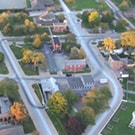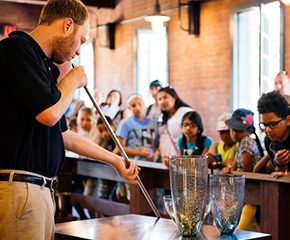
Liberty
Craftworks
Daily Activities at Liberty Craftworks
While there are no scheduled activities today, be sure to see our complete activities listing for upcoming offerings.
The rush of the mill pond draws you in as the sounds and motion of early American manufacturing surround you. Skilled artisans practice authentic period crafts and trades. View them all daily as they work with the techniques that are, in some cases, centuries old. Be sure to check out the Pottery Shop, which was recently renovated with a new indoor salt kiln and expanded workshop, and catch the glass blowing demonstrations in the 75-year-old Sandwich Glass Plant.
Highlights
Liberty Craftworks Store
Be captivated by American-made handcrafts in this Arts and Crafts-inspired store featuring those created by our own artisans.
Hours of Operation:
Closed for the season.
Glass Shop
Artifact
Factory (Structure)
Date Made
1931
Summary
The Glass Shop was constructed in 1930 to demonstrate the art of glass making as practiced in nineteenth century America. It was modeled after the Boston and Sandwich Glass House, located in Cape Cod, Massachusetts. In 2005, the shop was rebuilt, enlarged and updated with modern equipment. Today, our artisans create up to 10,000 pieces of historic and contemporary Studio Glass annually.
Object ID
30.2001.1
Credit
From the Collections of The Henry Ford.
Get more details in Digital Collections at:
Glass Shop
What is The Henry Ford?
The national attraction for discovering your ingenuity while exploring America’s spirit of innovation. There is always much to see and do at The Henry Ford.
Davidson-Gerson Gallery of Glass
Artifact
Building (Structure)
Date Made
1888
Summary
The Henry Ford's glass collection is one of the most comprehensive in the United States, numbering approximately 10,000 pieces. The gallery traces the history of American glass from the 18th century through the present, including works by important artists like Louis Comfort Tiffany and masters of the Studio Glass movement. Built as a machine shop in 1888 in Lapeer, Michigan, this building was moved to Greenfield Village in 1931.
Place of Creation
Object ID
29.3062.1
Credit
From the Collections of The Henry Ford.
Get more details in Digital Collections at:
Davidson-Gerson Gallery of Glass
What is The Henry Ford?
The national attraction for discovering your ingenuity while exploring America’s spirit of innovation. There is always much to see and do at The Henry Ford.
Pottery Shop
Artifact
Building (Structure)
Date Made
circa 1935
Summary
The Pottery Shop was designed in 1939 by Edward L. Cutler, an architect who helped Henry Ford create his historic village. Designed as a reproduction rice mill to house 19th-century threshing machinery from a South Carolina plantation, the building was repurposed as the Pottery Shop in 1984. Today, visitors view demonstrations of hand-made pottery including salt-glaze and slip wares.
Place of Creation
Object ID
40.583.1
Credit
From the Collections of The Henry Ford.
Get more details in Digital Collections at:
Pottery Shop
What is The Henry Ford?
The national attraction for discovering your ingenuity while exploring America’s spirit of innovation. There is always much to see and do at The Henry Ford.
Printing Office & Tin Shop
Artifact
Workshop (Work space)
Date Made
1933
Summary
The Printing Office was built in Greenfield Village in 1933. For decades, the building served as a utilitarian print shop for Greenfield Village. At one time, the building housed a recreated 19th-century small town newspaper print shop and tinsmithing studio. Now, only the print shop remains.
Place of Creation
Keywords
Object ID
33.710.1
Credit
From the Collections of The Henry Ford.
Get more details in Digital Collections at:
Printing Office & Tin Shop
What is The Henry Ford?
The national attraction for discovering your ingenuity while exploring America’s spirit of innovation. There is always much to see and do at The Henry Ford.
Armington & Sims Machine Shop
Artifact
Machine shop
Date Made
1930
Summary
This building essentially provides support for a system of shafts and pulleys that distribute mechanical energy to the rows of metal working machine tools arranged along the building's length. The machinists who worked in shops like this could tackle a wide range of jobs. America's nineteenth century machine shops were a training ground for many technological innovators.
Place of Creation
Keywords
Object ID
30.1999.1
Credit
From the Collections of The Henry Ford.
Get more details in Digital Collections at:
Armington & Sims Machine Shop
What is The Henry Ford?
The national attraction for discovering your ingenuity while exploring America’s spirit of innovation. There is always much to see and do at The Henry Ford.
Gunsolly Carding Mill
Artifact
Mill (Building)
Date Made
circa 1850
Summary
John Gunsolly operated this water-powered carding mill as well as a saw and cider mill on the Middle Rouge River near Plymouth, Michigan, beginning in the 1850s. Area farmers brought their wool to this mill to have it carded (combed) so it could be spun into thread.
Creators
Place of Creation
Keywords
Object ID
29.3056.1
Credit
From the Collections of The Henry Ford.
Get more details in Digital Collections at:
Gunsolly Carding Mill
What is The Henry Ford?
The national attraction for discovering your ingenuity while exploring America’s spirit of innovation. There is always much to see and do at The Henry Ford.
Loranger Gristmill
Artifact
Mill (Building)
Date Made
circa 1832
Summary
Gristmills -- usually among the earliest businesses established in a community -- ground grain harvested by local farmers. This mill, originally located in Monroe, Michigan, was set up to grind both corn and wheat. It incorporates a sophisticated conveyor system, developed by Oliver Evans in the late 1700s, that moves grain through the building to undergo a variety of processes.
Creators
Place of Creation
Keywords
Object ID
28.1001.1
Credit
From the Collections of The Henry Ford.
Get more details in Digital Collections at:
Loranger Gristmill
What is The Henry Ford?
The national attraction for discovering your ingenuity while exploring America’s spirit of innovation. There is always much to see and do at The Henry Ford.
Weaving Shop
Artifact
Mill (Building)
Date Made
circa 1840
Summary
The Greenfield Village Weaving Shop demonstrates the evolution of textile production from the colonial home and craft shop, through the Industrial Revolution to commercial factory. Housed in a converted 1840s Georgia cotton mill, the Weaving Shop contains a number of working looms, including one of the few operating mechanical Jacquard looms in North America.
Place of Creation
Keywords
Object ID
39.579.1
Credit
From the Collections of The Henry Ford.
Get more details in Digital Collections at:
Weaving Shop
What is The Henry Ford?
The national attraction for discovering your ingenuity while exploring America’s spirit of innovation. There is always much to see and do at The Henry Ford.
Liberty Craftworks Shop Online
Check out some of the sights you'll enjoy first-hand when you journey through the Liberty Craftworks district in Greenfield Village.













































